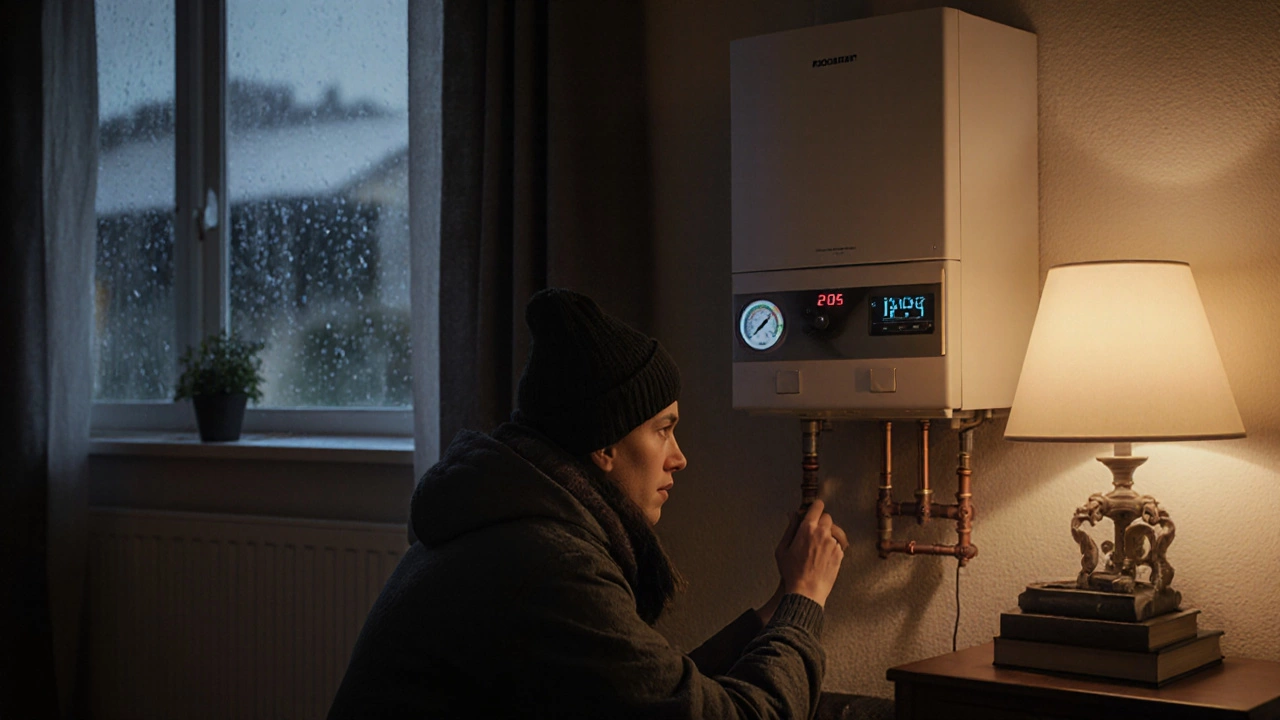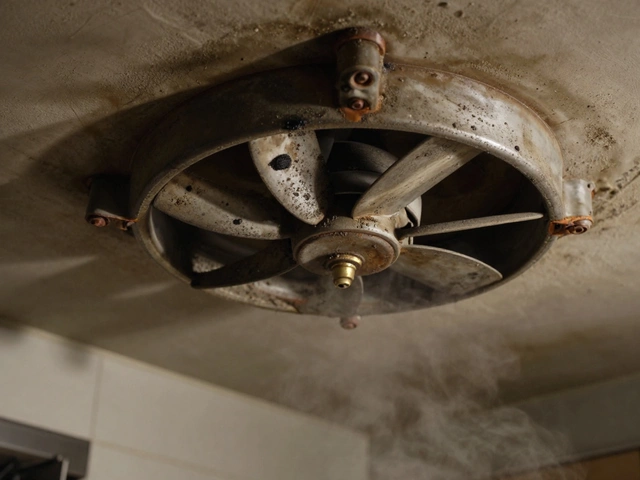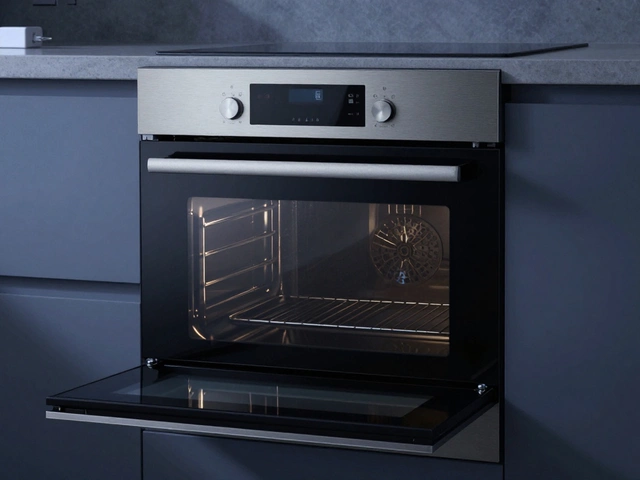Ever had your boiler stop working in the middle of a cold snap? It's annoying, sometimes stressful, and can be expensive. The first question most people ask is, "Can I just fix this myself?" There's a lot you actually can check before picking up the phone—or a wrench.
First, boilers aren't mystical machines. They're basically water heaters with extra parts and safety systems. Sometimes the fault isn't anything big. Maybe you lost pressure, your thermostat batteries died, or a fuse tripped. These are usually quick fixes—even for someone who doesn't know their spark plug from their spanner.
But here's something not everyone knows: in the UK, it's illegal for a non-certified person to tinker with gas or pressure-related boiler components. That means even if you watched a hundred YouTube tutorials, you can't unbolt panels or mess with gas supply lines unless you’re Gas Safe registered. Doing so can void your warranty, break the law, and put your home at real risk. But don't worry—there's still plenty you can safely check on your own before calling in the cavalry.
- Boiler Basics: What You're Dealing With
- Simple Fixes You Can Try
- When to Stop and Call a Pro
- The Real Dangers and Legal Issues
- Tools and Safety Gear for DIY
- Keeping Your Boiler Happy: Tips and Tricks
Boiler Basics: What You're Dealing With
If you’ve ever looked at your boiler and thought, “What’s going on in there?”, you’re not alone. Most modern boilers are not as complicated as they look. They heat water, usually run on gas or electricity, and move that hot water or steam through your radiators to keep your home warm. You’ll find a mess of pipes, a digital display, and usually a pressure gauge and reset button on the front.
Boilers mainly split into two types in UK homes: combi boilers and system boilers. Combi (combination) boilers do your hot water and heating in one unit—no need for big old water tanks in the loft. System boilers need a separate hot water tank, usually hidden away in a cupboard. Combi boilers are by far the most popular these days.
Here’s a quick table to show the main parts you’ll spot if you open the front panel on a boiler (just don’t touch anything gas-related):
| Part | What It Does |
|---|---|
| Heat Exchanger | Transfers heat from gas flame (or electric) to water |
| Burner | Where gas burns to heat water (gas boilers only) |
| Pump | Pushes hot water through your pipes and radiators |
| Pressure Gauge | Shows water pressure—this needs to be right for your boiler to work |
| Thermostat | Measures water or room temp and tells the boiler when to kick in |
One thing people often get wrong: losing pressure doesn’t mean the boiler is broken. Low pressure stops it working, but topping it up is sometimes all you need (more on that later). Also, if your system won’t start up, sometimes it’s just a frozen condensate pipe outside, especially in the winter. Pouring warm (not boiling) water over it is a classic fix.
Last thing: If you see a warning light, an error code, or hear weird bangs, it matters. Every sound and light is there for a reason—so don’t ignore them, thinking they’ll go away. Checking the manual (even the one hidden in your kitchen drawer) can save you time and money before you call for boiler repair help.
Simple Fixes You Can Try
Before you shell out cash for a pro, there are a few boiler repair steps you can safely try yourself. Most callouts are for stuff that’s surprisingly easy to sort at home. You don’t need fancy tools or deep knowledge—just a careful approach, and pay attention to what your boiler’s telling you.
Here’s what you can check:
- Check the pressure gauge: If your boiler pressure is below 1 bar (the usual sweet spot is between 1 and 1.5 bar), it probably won’t fire up. Most modern boilers have a simple filling loop. You can slowly add water, watching the gauge rise. Don’t overfill—just get it in range, then close the loop tight.
- Reset the boiler: Find the reset button (usually marked clearly). Hold it in for 10 seconds. If the fault code goes, you’re in business. If it keeps coming back, it’s time to stop and think.
- Bleed your radiators: If a room is cold but others aren’t, trapped air could be the problem. Use a radiator key and a rag. Crack open the valve until water hisses out, then shut it before it splutters. Air out, warmth back.
- Thermostat checks: Make sure it’s set to ‘on,’ and try fresh batteries if it’s wireless. Loads of boiler ‘failures’ are just outdated batteries or a bumped control dial.
- Inspect for obvious error codes: Some boilers have digital displays with codes. Look these up in your user manual (or on the manufacturer’s website). Sometimes the fix is as basic as closing a window (yep, some modern boilers won’t work if the air supply is out of whack).
- Fuse and power supply: Double-check the plug or fused spur feeding the boiler. Flipped breaker? Blown fuse? Replace or reset as needed.
If you're wondering how common these issues are, check this out:
| Reason for Boiler Trouble | % of Home Callouts (UK, 2023) |
|---|---|
| Low Pressure | 29% |
| Faulty Thermostat | 22% |
| Trapped Air (Radiators) | 17% |
| Power Supply Problem | 13% |
So, starting with these basic DIY boiler fix steps can actually save you time, money, and a headache. If things still don’t work after all this, don’t push it—there’s probably something going on inside that only a qualified engineer should touch.
When to Stop and Call a Pro
Playing handyman is all fun and games—until it’s not. With boiler repair, there’s a clear red line you shouldn’t cross. If your quick checks don’t fix the issue, or if you find anything you’re not 100% sure about, stop right there. Here’s the twist: under UK law, it’s illegal to work on any gas or pressure parts of your boiler unless you’re Gas Safe registered. Not just dangerous—illegal. And if something goes wrong, insurance won’t cover the damage.
Certain warning signs mean it’s time to back away from the boiler toolbox:
- Boiler leaks water or gas: Drips, puddles, or any odd smell like rotten eggs? Don’t risk it. Gas leaks can be deadly, and water leaks can ruin your home fast.
- Repeated loss of pressure: If topping up the pressure only works for a few days before the gauge drops again, there’s likely a deeper problem, like a leaky seal or crack inside the boiler.
- Unusual noises: Banging, gurgling, or a sound like a kettle boiling often point to trapped air, limescale, or a failing pump.
- Error codes or flashing lights: Modern boilers diagnose themselves. If you see any error display you don’t recognize, reach for your phone, not your screwdriver.
- No hot water or heating, even after reset: If the basics (pilot, thermostat, fuse) seem fine but nothing's working, it usually means something more technical has failed.
While you might be tempted to take on more, here’s a quick reality check:
| Task | DIY Safe? | Needs a Pro? |
|---|---|---|
| Resetting the boiler | Yes | No |
| Bleeding radiators | Yes | No |
| Replacing pressure valve | No | Yes |
| Fixing leaks or gas issues | No | Yes |
Here's the bottom line: if in doubt with any DIY boiler fix, don’t just Google your way through it. Boilers mean gas, fire, and water under pressure—three things you really don’t want to mess up. Call a professional who’s trained and certified in boiler repair. It might cost you a callout fee, but that’s nothing compared to the price of a botched job or a dangerous mistake.

The Real Dangers and Legal Issues
Boilers are no joke when it comes to safety. Trying to do a boiler repair yourself can put you on the wrong side of the law, especially in the UK and most parts of Europe. It’s actually illegal for anyone who isn’t Gas Safe registered to touch most gas boiler parts—even if you think you know what you’re doing. Insurance companies and warranty providers usually won’t cover damage if you’ve been poking around inside either. So if something big goes wrong, you’re on your own.
But it's not just about rules—it's about real risks. Boilers mix water, electricity, and flammable gas or oil. Mistakes can be deadly. Gas leaks are one problem, but carbon monoxide leaks are even scarier. You can’t see, taste, or smell it. According to NHS statistics, hundreds of people end up in hospital every year from carbon monoxide poisoning, and it still kills dozens across the UK annually.
If you’re still tempted, here are real dangers to think about:
- Explosion risk: Bad repairs can lead to pressure build-up, which can cause the boiler to blow. It doesn’t happen often, but it’s a nightmare when it does.
- Fire hazard: Faulty wiring or leaks after a DIY attempt can trigger a fire in your home.
- Gas leaks: These can be hard to spot and sometimes even small mistakes open the door to leaks.
- Legal fines: In the UK, you could get hit with fines up to £5,000 if you’re caught repairing your own gas appliances without being registered.
- Voided warranties: Messing with your boiler repair without qualifications usually breaks your warranty, meaning all future costs are on you.
| Known Boiler-Related Accident Stats (UK, 2023) | Number of Incidents |
|---|---|
| Reported gas explosions | 14 |
| CO poisoning hospitalisations* | 235 |
| DIY-related boiler fires | 8 |
*CO = Carbon Monoxide
Not every DIY boiler fix ends in disaster, but the stakes are high enough that the law takes it seriously for a reason. No YouTube hack is worth risking your house, health, or a criminal record. If you’re not registered, stick to the basics and call in a pro for anything else.
Tools and Safety Gear for DIY
If you're thinking about taking on boiler repair jobs yourself, you need the right gear. The last thing you want is to get hurt, blow a fuse, or cause a leak just because you grabbed the wrong tool or skipped the basics. For the simple fixes—like topping up pressure or checking the thermostat—you don’t need a toolbox fit for a mechanic. But some items really do matter.
- Insulated screwdriver: Essential for pressing reset buttons or dealing with electronic controls. Never use a random metal screwdriver because a stray spark can give you a shock.
- Adjustable wrench: Handy for gentle tightening on visible pipe joints or bleeding valves. Always double-check that you’re not touching anything sealed or gas-related.
- Pressure gauge or manometer: To read boiler pressure, though most modern boilers have these built in. If yours doesn’t work, it’s worth buying a cheap manual gauge.
- Protective gloves: A basic pair keeps your hands safe from sudden hot parts and any minor leaks.
- Eye protection: Dripping water, steam spitting out while bleeding a radiator—cheap goggles can save a trip to A&E.
- Small bucket or towel: Boilers love to make a mess when they finally let go of trapped water or gunk. Always place one under valves before you open anything.
If you’re going to be near any electrics, make sure the boiler is switched off at the mains—no shortcuts here. One 2023 study from SafeHome UK found that out of 500 boiler-related household injuries, about 60% came from people not shutting off power first. That’s an easy mistake to avoid.
For bigger fixes beyond the basics, like anything involving gas or pressure relief valves, even the best DIY kit won’t keep you safe. You need certified training and special tools that aren’t available to the public. Messing with gas supply lines or burners is illegal without a professional license, plain and simple.
Here’s a basic table of what’s okay for DIY and what’s definitely for the pros:
| DIY Friendly Tools | Professional-Only Tools |
|---|---|
| Insulated screwdriver | Gas leak detector |
| Adjustable wrench | Combustion analyzer |
| Pressure gauge | Boiler flue gas tester |
| Protective gloves/goggles | Specialist gas-tight seals |
Bottom line: Simple DIY boiler fix jobs are all about safety and patience. Don’t rush, and never poke around parts of the boiler you’re not 100% sure are safe. Always follow the manufacturer’s instructions that came with your boiler—it’s not just small print, it’s the difference between a quick fix and a costly disaster.
Keeping Your Boiler Happy: Tips and Tricks
If you want your boiler to last and fend off repairs, regular care really pays off. Most breakdowns come from neglect—just skipping a few basic steps can chop years off your boiler’s life.
The easiest way to dodge drama is by doing these things every year, or more often if you use hot water a lot or have hard water in your area:
- Bleed your radiators at least once a year. Trapped air blocks heat from getting around, so your boiler works harder and costs you more.
- Check the pressure. Most boilers need the pressure to sit between 1 and 1.5 bar when cold. If it regularly drops, you might have a leak, which needs a professional.
- Look for leaks or corrosion around your pipes and boiler. Catching small drips early keeps them from turning into expensive repairs.
- Test the thermostat and timers. Faulty settings can make you think your boiler’s broken, when really it’s just not switching on when it should.
- Clear the area around your boiler. Piled-up junk can block vents or make it overheat.
Don’t forget the annual service. In the UK, new boiler warranties usually demand it. Your warranty could be void otherwise—even if you never missed a payment. Plus, studies have shown that boilers serviced at least once a year have 30% fewer breakdowns compared to those left unchecked. Here’s a quick look:
| Servicing Frequency | Breakdown Rate per Year |
|---|---|
| Annual Servicing | About 1 in 10 |
| No Regular Servicing | About 1 in 3 |
Avoid using chemical cleaners unless a pro says so. They can mess with your system pressure and even wreck rubber seals inside. If you’ve got hard water, think about getting a magnetic filter or a whole-house water softener. Limescale is ruthless and can clog a brand-new boiler in just a couple years.
One last tip—keep an eye (and ear) out for strange noises. Gurgling, banging, or whistling could be air or limescale in the system. Don’t ignore them. Fixing a small problem right away beats shelling out for a full boiler repair when it’s too late.





